Lu Wang
CSSE, Shenzhen University
Blur-Robust Detection via Feature Restoration: An End-to-End Framework for Prior-Guided Infrared UAV Target Detection
Nov 18, 2025Abstract:Infrared unmanned aerial vehicle (UAV) target images often suffer from motion blur degradation caused by rapid sensor movement, significantly reducing contrast between target and background. Generally, detection performance heavily depends on the discriminative feature representation between target and background. Existing methods typically treat deblurring as a preprocessing step focused on visual quality, while neglecting the enhancement of task-relevant features crucial for detection. Improving feature representation for detection under blur conditions remains challenging. In this paper, we propose a novel Joint Feature-Domain Deblurring and Detection end-to-end framework, dubbed JFD3. We design a dual-branch architecture with shared weights, where the clear branch guides the blurred branch to enhance discriminative feature representation. Specifically, we first introduce a lightweight feature restoration network, where features from the clear branch serve as feature-level supervision to guide the blurred branch, thereby enhancing its distinctive capability for detection. We then propose a frequency structure guidance module that refines the structure prior from the restoration network and integrates it into shallow detection layers to enrich target structural information. Finally, a feature consistency self-supervised loss is imposed between the dual-branch detection backbones, driving the blurred branch to approximate the feature representations of the clear one. Wealso construct a benchmark, named IRBlurUAV, containing 30,000 simulated and 4,118 real infrared UAV target images with diverse motion blur. Extensive experiments on IRBlurUAV demonstrate that JFD3 achieves superior detection performance while maintaining real-time efficiency.
Seeing the Forest and the Trees: Query-Aware Tokenizer for Long-Video Multimodal Language Models
Nov 14, 2025Abstract:Despite the recent advances in the video understanding ability of multimodal large language models (MLLMs), long video understanding remains a challenge. One of the main issues is that the number of vision tokens grows linearly with video length, which causes an explosion in attention cost, memory, and latency. To solve this challenge, we present Query-aware Token Selector (\textbf{QTSplus}), a lightweight yet powerful visual token selection module that serves as an information gate between the vision encoder and LLMs. Given a text query and video tokens, QTSplus dynamically selects the most important visual evidence for the input text query by (i) scoring visual tokens via cross-attention, (ii) \emph{predicting} an instance-specific retention budget based on the complexity of the query, and (iii) \emph{selecting} Top-$n$ tokens with a differentiable straight-through estimator during training and a hard gate at inference. Furthermore, a small re-encoder preserves temporal order using absolute time information, enabling second-level localization while maintaining global coverage. Integrated into Qwen2.5-VL, QTSplus compresses the vision stream by up to \textbf{89\%} and reduces end-to-end latency by \textbf{28\%} on long videos. The evaluation on eight long video understanding benchmarks shows near-parity accuracy overall when compared with the original Qwen models and outperforms the original model by \textbf{+20.5} and \textbf{+5.6} points respectively on TempCompass direction and order accuracies. These results show that QTSplus is an effective, general mechanism for scaling MLLMs to real-world long-video scenarios while preserving task-relevant evidence. We will make all code, data, and trained models' weights publicly available.
Heterogeneous Complementary Distillation
Nov 14, 2025Abstract:Knowledge distillation (KD)transfers the dark knowledge from a complex teacher to a compact student. However, heterogeneous architecture distillation, such as Vision Transformer (ViT) to ResNet18, faces challenges due to differences in spatial feature representations.Traditional KD methods are mostly designed for homogeneous architectures and hence struggle to effectively address the disparity. Although heterogeneous KD approaches have been developed recently to solve these issues, they often incur high computational costs and complex designs, or overly rely on logit alignment, which limits their ability to leverage the complementary features. To overcome these limitations, we propose Heterogeneous Complementary Distillation (HCD),a simple yet effective framework that integrates complementary teacher and student features to align representations in shared logits.These logits are decomposed and constrained to facilitate diverse knowledge transfer to the student. Specifically, HCD processes the student's intermediate features through convolutional projector and adaptive pooling, concatenates them with teacher's feature from the penultimate layer and then maps them via the Complementary Feature Mapper (CFM) module, comprising fully connected layer,to produce shared logits.We further introduce Sub-logit Decoupled Distillation (SDD) that partitions the shared logits into n sub-logits, which are fused with teacher's logits to rectify classification.To ensure sub-logit diversity and reduce redundant knowledge transfer, we propose an Orthogonality Loss (OL).By preserving student-specific strengths and leveraging teacher knowledge,HCD enhances robustness and generalization in students.Extensive experiments on the CIFAR-100, Fine-grained (e.g., CUB200)and ImageNet-1K datasets demonstrate that HCD outperforms state-of-the-art KD methods,establishing it as an effective solution for heterogeneous KD.
GUI-360$^\circ$: A Comprehensive Dataset and Benchmark for Computer-Using Agents
Nov 10, 2025Abstract:We introduce GUI-360$^\circ$, a large-scale, comprehensive dataset and benchmark suite designed to advance computer-using agents (CUAs). CUAs present unique challenges and is constrained by three persistent gaps: a scarcity of real-world CUA tasks, the lack of automated collection-and-annotation pipelines for multi-modal trajectories, and the absence of a unified benchmark that jointly evaluates GUI grounding, screen parsing, and action prediction. GUI-360$^\circ$ addresses these gaps with an LLM-augmented, largely automated pipeline for query sourcing, environment-template construction, task instantiation, batched execution, and LLM-driven quality filtering. The released corpus contains over 1.2M executed action steps across thousands of trajectories in popular Windows office applications, and includes full-resolution screenshots, accessibility metadata when available, instantiated goals, intermediate reasoning traces, and both successful and failed action trajectories. The dataset supports three canonical tasks, GUI grounding, screen parsing, and action prediction, and a hybrid GUI+API action space that reflects modern agent designs. Benchmarking state-of-the-art vision--language models on GUI-360$^\circ$ reveals substantial out-of-the-box shortcomings in grounding and action prediction; supervised fine-tuning and reinforcement learning yield significant gains but do not close the gap to human-level reliability. We release GUI-360$^\circ$ and accompanying code to facilitate reproducible research and accelerate progress on robust desktop CUAs. The full dataset has been made public on https://huggingface.co/datasets/vyokky/GUI-360.
GUI-360: A Comprehensive Dataset and Benchmark for Computer-Using Agents
Nov 06, 2025Abstract:We introduce GUI-360$^\circ$, a large-scale, comprehensive dataset and benchmark suite designed to advance computer-using agents (CUAs). CUAs present unique challenges and is constrained by three persistent gaps: a scarcity of real-world CUA tasks, the lack of automated collection-and-annotation pipelines for multi-modal trajectories, and the absence of a unified benchmark that jointly evaluates GUI grounding, screen parsing, and action prediction. GUI-360$^\circ$ addresses these gaps with an LLM-augmented, largely automated pipeline for query sourcing, environment-template construction, task instantiation, batched execution, and LLM-driven quality filtering. The released corpus contains over 1.2M executed action steps across thousands of trajectories in popular Windows office applications, and includes full-resolution screenshots, accessibility metadata when available, instantiated goals, intermediate reasoning traces, and both successful and failed action trajectories. The dataset supports three canonical tasks, GUI grounding, screen parsing, and action prediction, and a hybrid GUI+API action space that reflects modern agent designs. Benchmarking state-of-the-art vision--language models on GUI-360$^\circ$ reveals substantial out-of-the-box shortcomings in grounding and action prediction; supervised fine-tuning and reinforcement learning yield significant gains but do not close the gap to human-level reliability. We release GUI-360$^\circ$ and accompanying code to facilitate reproducible research and accelerate progress on robust desktop CUAs. The full dataset has been made public on https://huggingface.co/datasets/vyokky/GUI-360.
LiveOIBench: Can Large Language Models Outperform Human Contestants in Informatics Olympiads?
Oct 10, 2025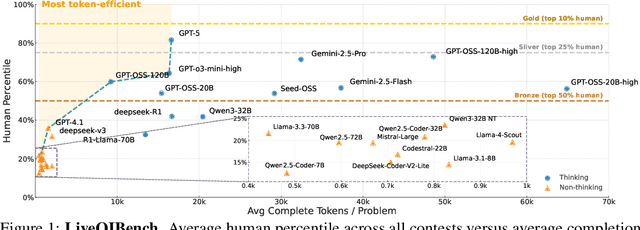
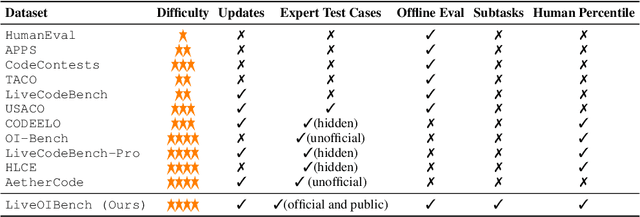
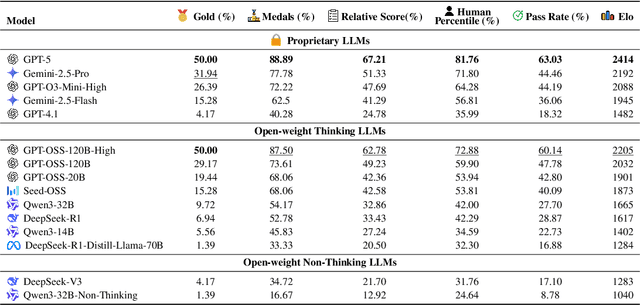
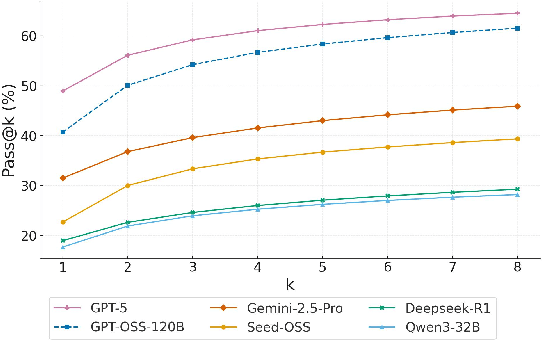
Abstract:Competitive programming problems increasingly serve as valuable benchmarks to evaluate the coding capabilities of large language models (LLMs) due to their complexity and ease of verification. Yet, current coding benchmarks face limitations such as lack of exceptionally challenging problems, insufficient test case coverage, reliance on online platform APIs that limit accessibility. To address these issues, we introduce LiveOIBench, a comprehensive benchmark featuring 403 expert-curated Olympiad-level competitive programming problems, each with an average of 60 expert-designed test cases. The problems are sourced directly from 72 official Informatics Olympiads in different regions conducted between 2023 and 2025. LiveOIBench distinguishes itself through four key features: (1) meticulously curated high-quality tasks with detailed subtask rubrics and extensive private test cases; (2) direct integration of elite contestant performance data to enable informative comparison against top-performing humans; (3) planned continuous, contamination-free updates from newly released Olympiad problems; and (4) a self-contained evaluation system facilitating offline and easy-to-reproduce assessments. Benchmarking 32 popular general-purpose and reasoning LLMs, we find that GPT-5 achieves a notable 81.76th percentile, a strong result that nonetheless falls short of top human contestant performance, who usually place above 90th. In contrast, among open-weight reasoning models, GPT-OSS-120B achieves only a 60th percentile, underscoring significant capability disparities from frontier closed models. Detailed analyses indicate that robust reasoning models prioritize precise problem analysis over excessive exploration, suggesting future models should emphasize structured analysis and minimize unnecessary exploration. All data, code, and leaderboard results will be made publicly available on our website.
SimCast: Enhancing Precipitation Nowcasting with Short-to-Long Term Knowledge Distillation
Oct 09, 2025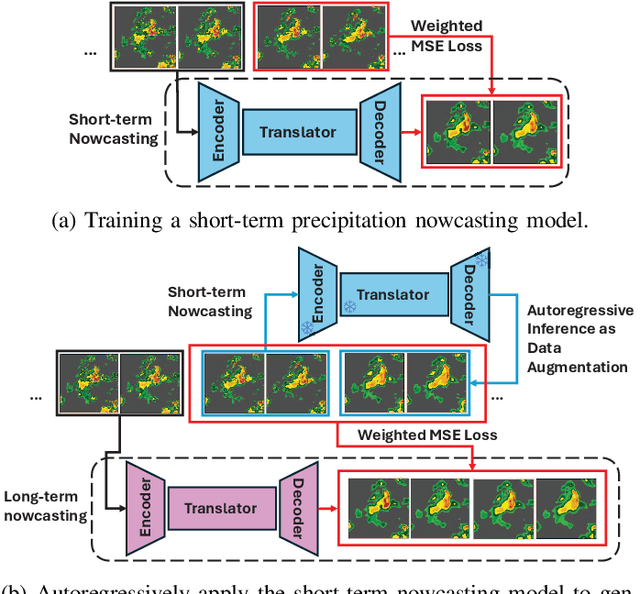



Abstract:Precipitation nowcasting predicts future radar sequences based on current observations, which is a highly challenging task driven by the inherent complexity of the Earth system. Accurate nowcasting is of utmost importance for addressing various societal needs, including disaster management, agriculture, transportation, and energy optimization. As a complementary to existing non-autoregressive nowcasting approaches, we investigate the impact of prediction horizons on nowcasting models and propose SimCast, a novel training pipeline featuring a short-to-long term knowledge distillation technique coupled with a weighted MSE loss to prioritize heavy rainfall regions. Improved nowcasting predictions can be obtained without introducing additional overhead during inference. As SimCast generates deterministic predictions, we further integrate it into a diffusion-based framework named CasCast, leveraging the strengths from probabilistic models to overcome limitations such as blurriness and distribution shift in deterministic outputs. Extensive experimental results on three benchmark datasets validate the effectiveness of the proposed framework, achieving mean CSI scores of 0.452 on SEVIR, 0.474 on HKO-7, and 0.361 on MeteoNet, which outperforms existing approaches by a significant margin.
* accepted by ICME 2025
Do LLMs Really Need 10+ Thoughts for "Find the Time 1000 Days Later"? Towards Structural Understanding of LLM Overthinking
Oct 09, 2025Abstract:Models employing long chain-of-thought (CoT) reasoning have shown superior performance on complex reasoning tasks. Yet, this capability introduces a critical and often overlooked inefficiency -- overthinking -- models often engage in unnecessarily extensive reasoning even for simple queries, incurring significant computations without accuracy improvements. While prior work has explored solutions to mitigate overthinking, a fundamental gap remains in our understanding of its underlying causes. Most existing analyses are limited to superficial, profiling-based observations, failing to delve into LLMs' inner workings. This study introduces a systematic, fine-grained analyzer of LLMs' thought process to bridge the gap, TRACE. We first benchmark the overthinking issue, confirming that long-thinking models are five to twenty times slower on simple tasks with no substantial gains. We then use TRACE to first decompose the thought process into minimally complete sub-thoughts. Next, by inferring discourse relationships among sub-thoughts, we construct granular thought progression graphs and subsequently identify common thinking patterns for topically similar queries. Our analysis reveals two major patterns for open-weight thinking models -- Explorer and Late Landing. This finding provides evidence that over-verification and over-exploration are the primary drivers of overthinking in LLMs. Grounded in thought structures, we propose a utility-based definition of overthinking, which moves beyond length-based metrics. This revised definition offers a more insightful understanding of LLMs' thought progression, as well as practical guidelines for principled overthinking management.
Linear-Time Demonstration Selection for In-Context Learning via Gradient Estimation
Aug 27, 2025



Abstract:This paper introduces an algorithm to select demonstration examples for in-context learning of a query set. Given a set of $n$ examples, how can we quickly select $k$ out of $n$ to best serve as the conditioning for downstream inference? This problem has broad applications in prompt tuning and chain-of-thought reasoning. Since model weights remain fixed during in-context learning, previous work has sought to design methods based on the similarity of token embeddings. This work proposes a new approach based on gradients of the output taken in the input embedding space. Our approach estimates model outputs through a first-order approximation using the gradients. Then, we apply this estimation to multiple randomly sampled subsets. Finally, we aggregate the sampled subset outcomes to form an influence score for each demonstration, and select $k$ most relevant examples. This procedure only requires pre-computing model outputs and gradients once, resulting in a linear-time algorithm relative to model and training set sizes. Extensive experiments across various models and datasets validate the efficiency of our approach. We show that the gradient estimation procedure yields approximations of full inference with less than $\mathbf{1}\%$ error across six datasets. This allows us to scale up subset selection that would otherwise run full inference by up to $\mathbf{37.7}\times$ on models with up to $34$ billion parameters, and outperform existing selection methods based on input embeddings by $\mathbf{11}\%$ on average.
Explainable Counterfactual Reasoning in Depression Medication Selection at Multi-Levels (Personalized and Population)
Aug 24, 2025Abstract:Background: This study investigates how variations in Major Depressive Disorder (MDD) symptoms, quantified by the Hamilton Rating Scale for Depression (HAM-D), causally influence the prescription of SSRIs versus SNRIs. Methods: We applied explainable counterfactual reasoning with counterfactual explanations (CFs) to assess the impact of specific symptom changes on antidepressant choice. Results: Among 17 binary classifiers, Random Forest achieved highest performance (accuracy, F1, precision, recall, ROC-AUC near 0.85). Sample-based CFs revealed both local and global feature importance of individual symptoms in medication selection. Conclusions: Counterfactual reasoning elucidates which MDD symptoms most strongly drive SSRI versus SNRI selection, enhancing interpretability of AI-based clinical decision support systems. Future work should validate these findings on more diverse cohorts and refine algorithms for clinical deployment.
 Add to Chrome
Add to Chrome Add to Firefox
Add to Firefox Add to Edge
Add to Edge